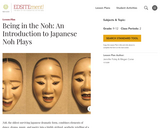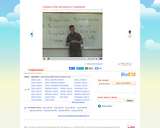
This video examines active voice and passive voice, explaining the linguistic difference between them and how to use them in sentences.
- Subject:
- English Language Arts
- Material Type:
- Lesson
- Provider:
- NeoK12
- Date Added:
- 02/26/2019

This video examines active voice and passive voice, explaining the linguistic difference between them and how to use them in sentences.

In this lesson, students will learn how to incorporate parallel structure and varied phrases into their argument revisions.

In this lesson, students will learn how to construct parallel structure in orer to enhance their narratives.

In this lesson, students will learn how to incorporate parallel structure and varied phrases into their informative drafts.

In this lesson on narrative writing, students will learn how to use parallel structure in order to improve their drafts.

This video explains the definition and use of adverbs and gives an example of an adverb being used in three situations.

Worksheets and lessons on adverbs and adjectives for various reading levels.

This video demonstrates how to use commas to separative appositive phrases from sentences.

Noh, the oldest surviving Japanese dramatic form, combines elements of dance, drama, music, and poetry into a highly stylized, aesthetic retelling of a well-known story from Japanese literature, such as The Tale of Genji or The Tale of the Heike. This lesson provides an introduction to the elements of Noh plays and to the text of two plays, and provides opportunities for students to compare the conventions of the Noh play with other dramatic forms with which they may already be familiar, such as the ancient Greek dramas of Sophocles. By reading classic examples of Noh plays, such as Atsumori, students will learn to identify the structure, characters, style, and stories typical to this form of drama. Students will expand their grasp of these conventions by using them to write the introduction to a Noh play of their own.

Few mistakes sour good writing like nominalizations, or, as Helen Sword likes to call them, zombie nouns. Zombie nouns transform simple and straightforward prose into verbose and often confusing writing. Keep your nouns away from elongating nominalizations!

Worksheets and lessons on the correct use of prepositions for various reading levels.

This resource provides practice and explanation for students on how to use a semicolon as well as a conjunctive adverb for joining two independent clauses.

This video examines the use of coordinating conjunctions to avoid comma splice errors when combining independent clauses in sentences.

This video discusses the use of copulative (linking) verbs and subjective complements in sentences.

In this lesson, teachers scaffold student reading of websites that highlight science, technology, engineering, and mathematics careers. Before choosing a text for close reading, the teacher models how to "read" the variety of texts and features of different websites, including images and interactives. Then the teacher models a close reading with students, setting a purpose and asking text-dependent questions to help students find evidence, use inferencing skills, and peer edit.

In this lesson, students will work together to develop and strengthen their writing, focusing on unity, coherence, logical sequence, integrating evidence, and grammar.

Students will read and analyze sonnets to discover their traditonal forms. Students will chart the poems' characteristics, including the poetic features and their emtional responses to the poems. Then they review the details for similarities, deducing traditional sonnet forms that the poems have in common. After this introduction, students write original sonnets, using one of the poems they have analyzed as a model.

In the TED Ed lesson focused on grammar, students will explore the age-old argument between linguistic prescriptivists and descriptivists — who have two very different opinions on the matter. Discussion questions and additional resources are linked in the sidebar.

As a way to support teachers with English Language Arts (ELA) instruction during the pandemic, the NCDPI ELA team created choice boards featuring standards-aligned ELA activities.The intended purpose of these choice boards is to provide a way for students to continue standards-based learning while schools are closed. Each activity can be adapted and modified to be completed with or without the use of digital tools. Many activities can also be repeated with different texts. These standards-based activities are meant to be a low-stress approach to reinforcing and enriching the skills learned during the 2019-2020 school year. The choice boards are to be used flexibly by teachers, parents, and students in order to meet the unique needs of each learner.Exploration activities are provided for a more self-directed or guided approach to independent learning for students. These activities and sites should be used as a way to explore concepts, topics, skills, and social and emotional competencies that interest the learner.

This tutorial and self-test focuses on the most common grammatical mistakes made in writing. The mistakes are organized under 13 grammatical categories. In each of these categories, the tutorial presents an error, explains it, and shows ways of avoiding or correcting it.